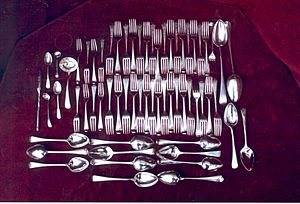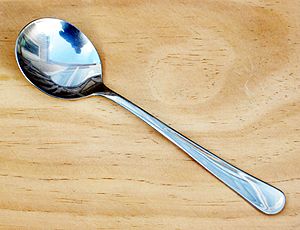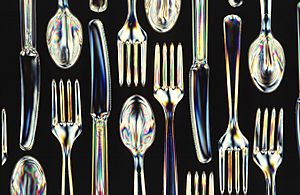Cutlery facts for kids
Cutlery refers to the tools we use to prepare, serve, and especially eat our food. Think of knives, forks, and spoons! A person who makes or sells these items is called a cutler. The city of Sheffield in England has been well-known for making cutlery since the 1600s. There's even a train called the Master Cutler that runs from Sheffield to London, named after this important industry.
In the United States, cutlery is often called silverware or flatware. However, the word cutlery there usually means just knives and other cutting tools. Even if your forks and spoons aren't made of real silver, people still might call them silverware. To avoid confusion, some people use the term tableware instead.
The main types of cutlery used in many parts of the world are the knife, fork, and spoon. Sometimes, you might even find a "sporf," which is a fun tool that combines all three!
Contents
What Does "Cutlery" Mean?
The word "cutlery" comes from an old English word, 'cuteler'. This word itself came from the Old French word 'coutelier', which means someone who makes or sells knives. The French word 'coutel' means knife, and its roots go back to the Latin word 'culter', also meaning knife.
People in Sheffield were making knives a very long time ago. The first time the word "cutler" was officially written down in Sheffield was in a tax record from 1297. About 50 years later, a knife made in Sheffield was even found in the King's belongings at the Tower of London. You can still see some knives from the 1300s at the Cutlers' Hall in Sheffield today.
What Is Cutlery Made From?

For a long time, sterling silver was the best material for making high-quality cutlery. This is why people in the United States still use the term "silverware." Silver was a good choice because it didn't react much with different foods, which could make your meal taste strange. Gold is even less reactive than silver, but only very rich people, like kings and queens, could afford gold cutlery.
For everyday knives, steel was always used. Cheaper items, especially spoons, were sometimes made from pewter. Later, in the 1800s, a material called electroplated nickel silver (EPNS) became popular. It was a cheaper way to get the look of sterling silver.
A big change happened in 1913 when a British scientist named Harry Brearley accidentally discovered stainless steel. This metal doesn't rust or stain easily, and it's now the most common material for cutlery. Another option is melchior, which is a strong, corrosion-resistant mix of nickel and copper.
Disposable Cutlery
Have you ever used a plastic fork at a picnic or a fast-food restaurant? That's disposable cutlery! It's super handy because it's light and you don't have to wash it after eating. This type of cutlery, usually made of plastic, has become a huge business all over the world.
Disposable cutlery, along with paper plates and plastic cups, is very common in the fast food and catering industries. It's also often given with airline meals in economy class or used for camping and barbecues. While convenient, these products create millions of tons of plastic waste that doesn't break down easily. Luckily, you can now find wooden disposable cutlery, which is a better choice because it's biodegradable and can break down naturally.
Where Is Cutlery Made?
Many places around the world are famous for making cutlery. Some of the traditional centers include:
- Albacete in Spain
- Oneida in the United States
- Premana in Italy
- Sheffield in the United Kingdom
- Solingen in Germany
- Thiers and Laguiole in France
- Toledo in Spain
- Wazirabad in Pakistan
Images for kids
-
An example of modern cutlery, design by architect and product designer Zaha Hadid (2007).
-
A table setting for an eight-course meal. It includes a butter spreader resting on a crystal stand; a cocktail fork, soup spoon, dessert fork, dessert spoon and an ice cream fork, as well as separate knives and forks for fish, entrée, main course and salad
See also
 In Spanish: Cubertería para niños
In Spanish: Cubertería para niños







